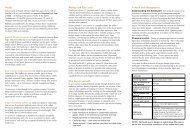Bushland Weeds Manual - Environmental Weeds Action Network
Bushland Weeds Manual - Environmental Weeds Action Network
Bushland Weeds Manual - Environmental Weeds Action Network
Create successful ePaper yourself
Turn your PDF publications into a flip-book with our unique Google optimized e-Paper software.
Impacts<br />
Invasive woody species can have profound effects on<br />
the structure and diversity of the invaded bushland.<br />
Weedy trees and shrubs often form dense stands,<br />
shading out and preventing the germination and<br />
establishment of native species (Gleadow and Ashton<br />
1981, Gleadow 1982, Weiss and Noble 1984, Rose and<br />
Fairweather 1997, Goodland et al. 1998, Mullett 2002).<br />
Over a 25 year period at Croydon North in Melbourne,<br />
scattered plants of Sweet Pittosporum (Pittosporum<br />
undulatum) coalesced into a dense stand, obliterating<br />
nearly all the original understorey (Gleadow and<br />
Ashton 1981). Closer to home, on the Darling Scarp<br />
east of Perth, stands of eastern Australian Acacias,<br />
including Cootamundra Wattle (Acacia baileyana),<br />
Silver Wattle (Acacia dealbata) and Flinders Range<br />
Wattle (Acacia iteaphylla), form dense stands in the<br />
understorey of the Jarrah Forest. The establishment of<br />
dense weed infestations also impact on the fauna.<br />
Habitat and food sources are lost, which may lead to<br />
decreases in native animal diversity.<br />
It may only require one or two plants to establish and<br />
reach maturity for the source of an infestation to form.<br />
The seed rain that follows, coupled with the ability to<br />
germinate in shady conditions and/or take rapid<br />
advantage of disturbance events, is enough to allow<br />
dense establishment of the plant. In Kings Park and<br />
Botanic Garden, Perth, a small number of Acacia<br />
lasiocalyx were planted on the edge of bushland<br />
around 1967. A wildfire in 1989 resulted in mass<br />
germination of the species and it was realised this<br />
Western Australian Wheatbelt species had become a<br />
serious weed. By 1993, when the non-sprouting trees<br />
were cut out by a group of dedicated volunteers,<br />
A. lasiocalyx had covered 0.6 hectares of the park’s<br />
bushland area (Dixon 2001, Dixon pers. comm. 2002).<br />
A dense infestation of Acacia lasiocalyx in Kings Park <strong>Bushland</strong>.<br />
(Photograph by Bob Dixon).<br />
Chapter 6 Trees, Shrubs and Climbers<br />
Mechanisms of spread<br />
Woody plants may reproduce by seed, or create clones<br />
from vegetative fragments or propagules. Dispersal of<br />
propagules, over short or long distances, followed by<br />
successful establishment results in the spread of the<br />
plant.<br />
• Birds, insects and mammals spread the seeds of<br />
many invasive woody species. Seeds of Brazilian<br />
Pepper (Schinus terebinthifolius), Edible Fig (Ficus<br />
carica) and Blackberry (Rubus spp) are all ingested<br />
by birds and germinate in their droppings. Finding<br />
weed species growing at the base of perching trees<br />
is a good indication that these particular weeds<br />
are spread by birds (Gleadow 1982, Blood 2001).<br />
Propagules also attach to feathers and fur or can<br />
be carried by ants (many Acacia species).<br />
• Wind is an effective disperser of seed especially if<br />
an individual plant emerges above the canopy (eg.<br />
Tamarisk, Sheoaks and Eucalypts). Dispersal<br />
distance is considerably less than with birddisseminated<br />
species.<br />
• Water can carry propagules down stream and,<br />
during floods, to distant sites. The seeds of many<br />
Acacia species, stems of Willows (Salix spp), and<br />
aerial tubers of Madeira Vine (Anredera cordifolia)<br />
are all carried by water.<br />
• Garden rubbish dumped in bushland introduces<br />
various weed propagules. Cuttings of Australian<br />
natives, especially eastern Australian Bottlebrush<br />
(Callistemon) and Wattle (Acacia) species, are<br />
commonly dumped in bushland under the<br />
misguided belief that they came from there!<br />
• Planting of non-local tree species within bushland<br />
can also be the source of woody weed invasions<br />
(eastern Australian species and Western Australian<br />
species planted outside their natural range).<br />
• Individual plants may spread locally by vegetative<br />
reproduction - stem layering or root suckering.<br />
Resprouting, suckering and apical control<br />
Resprouting and suckering are mechanisms by which<br />
many woody plants resist or recover from fire, storm<br />
or grazing damage.<br />
Suckering is the formation of sprouts from<br />
adventitious buds in the lateral roots. Suckers arise<br />
most often at root branch intersections, areas of root<br />
irregularity or points of injury. Individual plants form<br />
as the sucker develops its own root system and old<br />
root connections are broken. Some species sucker in<br />
response to crown removal or root damage.<br />
75



